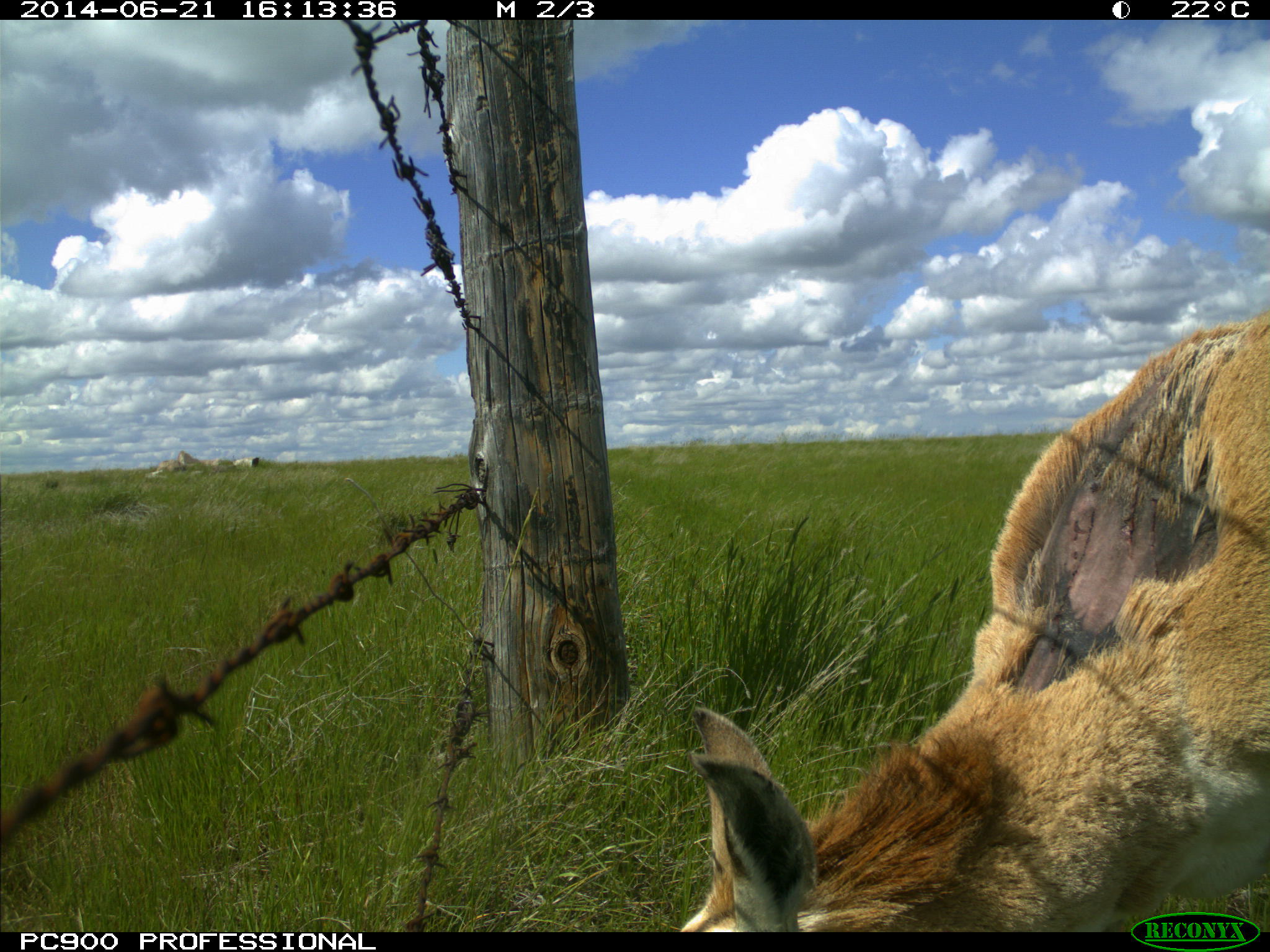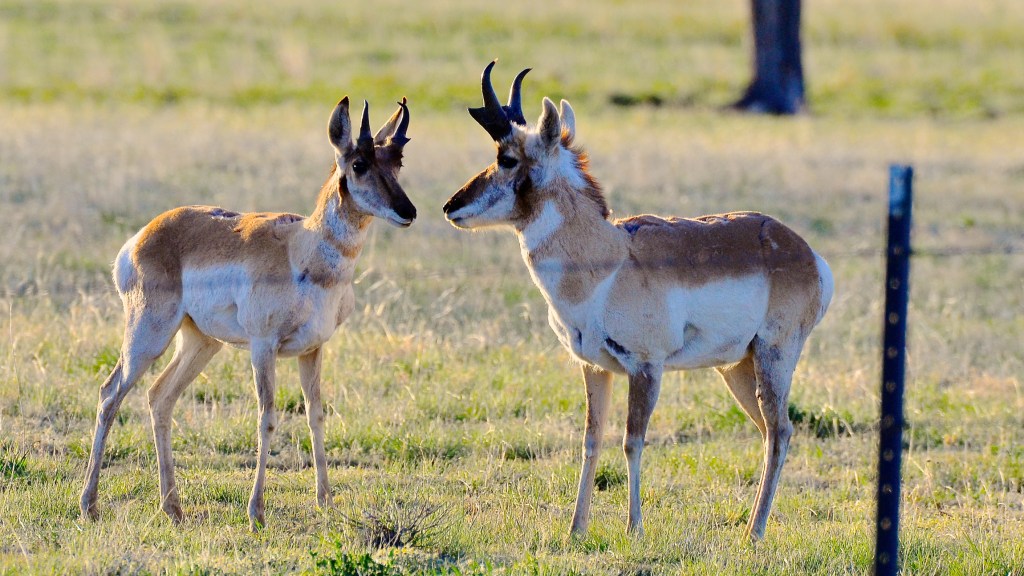Pronghorn may be the second fastest land mammal on Earth, but a simple fence can stop them in their tracks. Their speed has allowed them to roam the continent for millennia, surviving the age of the wooly mammoth and saber-toothed tiger, but it is geography and evolution that account for one notable shortcoming.
“People want to know why they don’t jump,” says University of Montana wildlife biologist Andrew Jakes. “Pronghorn are a highly adapted species to open landscapes. Although they have the ability to jump, they typically crawl under fencing since, for eons, they never had to jump over anything taller than sagebrush.”

In a Western landscape crisscrossed with thousands of miles of barbed-wire fencing, these migrating animals face a real dilemma.
The biggest problem is that the bottom wire of many fences is strung too low for pronghorn to crawl under safely. “Even when they can squeeze under, the barbed wire often scrapes off hide,” says Montana Grasslands Conservation Director Brian Martin. “That exposes the animals to infection and frostbite.”

Pronghorn are known to travel many extra miles searching for places to cross a fence during migration, burning up calories that will be vital to get them through the long northern winters.
That’s why Jakes, Martin and the staff of the Conservancy’s Matador Ranch joined with the Alberta Conservation Association to study the best ways to modify fences so that they allow pronghorn to pass through them safely, while keeping cattle inside.
The researchers studied three different modifications on the Matador Ranch in Montana and locations in Alberta. Each raised the bottom wire to a minimum of 18” off the ground – high enough for the pronghorn and young deer and elk to get under, but low enough to contain cattle. In one case, they replaced the lowest barbed wire with a smooth wire.

In the second they encased the lowest wire in plastic pipe – a so-called “goat bar.” Both those methods created a smooth bottom surface.

In the third, they lifted the lowest wire by clipping it to the one above with an inexpensive carabiner.

While all three methods created enough space to crawl under, both pronghorn and deer completely balked at the goat bar. That was an important discovery since the method has been a commonly recommended solution by wildlife agencies.
For many landowners, the carabiner method may be the way to go.
“Raising bottom fence wires with a clip can be a great first step in enhancing the passage for pronghorn, given how quickly it can be accomplished for a minimum cost,” says the Conservancy’s Martin.
The researchers also confirmed that pronghorn are creatures of habit. They tend to return to the same crossing points year after year, and they condition their young to do the same. That finding helps us make smart decisions about where to remove or modify fences or where to simply leave gates open during times of deep snow and critical migration periods.

With pronghorn seasonally migrating more than 200 miles each way between their summer grounds in Canada and their wintering grounds in Montana, eliminating obstacles to their movement can be a matter of life and death.
Of course, the best fence for wildlife is no fence at all, so in addition to modifying miles of fencing, the Conservancy and our partners are completely removing many more miles.




As for the Goat Bar is concerned, I think it is the color that bothers them… try black or even green….
Wildlife-friendly fencing is just as important in the eastern U.S. as well. We refer to the fences on our Mid-Atlantic horse farm as “turtle friendly.” None of our fences are barbed wire (very dangerous for horses), and we use woven wire. We set the fence a minimum of 12 inches off the ground to allow wild animals to crawl under. Otherwise, the fence not only deters wildlife, but can even kill it when animals such as young fawns become entrapped in the wire. The higher height at the top has the added advantage of preventing horses from leaning over the top and bending the wire. P.S. We have a conservation easement with TNC.
Save the Animals.
Colorado Division of Wildlife (now Parks and Wildlife) has been advocating for wildlife fencing for many years. Their latest updated 40 page pamphlet came out in 2009 – here it is: http://wildlifefriendly.org/wp-content/uploads/2015/09/fencingwithwildlifeinmind_coloradodow.pdf
Smooth wire and smart spacing is being adopted faster than I would have imagined.
While smart fencing is important, I guarantee that Pronghorns can jump (see the cover of the above pamphlet). I also know that they can dive under fences at full speed – even under wires that appear too low for their bodies to fit under. It’s amazing to watch – it’s as if they just bounce off the ground, under fences, at 30 mph.
You would be correct that “no fence at all” is best for wildlife, IF we hadn’t invented roads. That changes the dynamic. Roads are probably here to stay.
We need to share our world with other creatures, and accomodate accordingly to save wildlife.
Thank you for looking out for these magnificent creatures. They deserve to go where they need to in order to survive, with integrity. It was interesting to note that they did not adapt to the pvc pipe, perhaps they know that that type of plastic is inherently evil due to it’s toxicity, ha ha. Seriously, thank YOU!!!!!!!
Adaria A.
Thanks for this work. Many ranchers do, in fact, care about the wildlife. A great many of them would not care to be ranchers if they did not care about animals– IMHO, as a ranch child. Regarding the fences–many of the fences are government, Bureau of Land Management fences. Those fences need to be identified and the government needs to deal with these fences. Ranchers are not able to do anything about those fences, regardless of their feelings.
As an aside, many antelope jumped into the yard of the ranch house in NM where I grew up. There were thousands of antelope then, now there are nearly none. Very sadly.
What an interesting and great article! It is so uplifting to read that you’re finding ways to help these beautiful animals migrate instinctively, and especially that farmers are willing to help them out and reduce harm and I’m sure sometimes death. The fact about the goat bar was fascinating and insightful for all. Great news!
New Mexico is a fence-out state. This means if I want to keep cattle off my property I must put up a fence. I put plastic pipe on the top wire to ease the passage of elk and it seems to work nicely. I will now cinch up the bottom two wires at intervals to help any pronghorn (they come close but we are hilly piñon/juniper habitat which they don’t like). They may come one day, though.
Good article. I have lived in the Texas Panhandle all of my life so far! About two months ago I saw an Antelope jump a fence. He cleard it easily? I had always thought they couldn’t jump. Could they be evolving?
Several years ago while driving across northeast Wyoming, my wife and I saw a small herd of pronghorns approach a barbed wire fence. We stopped to watch, fully expecting them to find ways to maneuver under the lowest wire. Much to our surprise one of the pronghorns backed away from the fence, then ran toward it and leaped over it. One-by-one the rest of the herd followed the example of its “leader” and leaped over the fence. Although crawling under a fence may be the standard “way of the pronghorn”, some of them can and will clear a fence by leaping over it. A question remains as to whether or not the members of this small herd always leap over fences, or only do it under specific circumstances. Such questions remain to be answered, at least for us. Perhaps experts on pronghorn behavior can provide answers.
When I was a Grad student at U Wyo, I rode bicycles outside town, and I often saw pronghorn dive under fences. They most often used a ravine or other low spot to make the crossing easier.
Boy, this was eye-opening! I had no idea what ranchers were doing to help pronghorn migrate across their property. Thank you ranchers! I learned a great deal about which wire method worked best. I want to thank you for breaking up my afternoon with cool science!
Great reporting, Bebe! Thanks for sharing this great science from Montana. It has particular relevance for our ungulate work in Wyoming, as well!
Beautiful animals and magnificent work you all do to protect them and all wild life. Thank you.